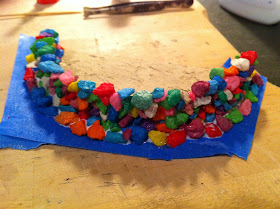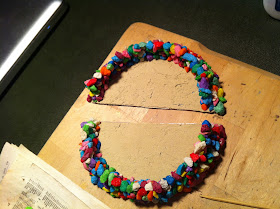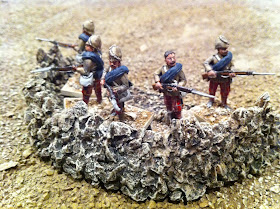Like one of my favorite fellow bloggers -- Willie Anderson, over at "The Anderson Collection" -- not long ago I was surprised to learn I'd reached the built-in limit for image-storage on this blog-site -- at least "free" image-storage. After sucking it up and signing on to pay a just-above-nominal-monthly-fee to free up a few more mega-bytes of image space, I am returning to blog about building some SANGARS -- defensive positions made from loose rock.
Here's a picture from an April 1878 issue of The Illustrated London News, showing a Gurkha attack on a line of hilltop sangars during the early phase of the Second Afghan War:
And here's an 1878 photograph by John Burke, titled, "Afridi Picket near to Jumrood", which may well be familiar to those of you with an interest in the Second Afghan War, showing a group of Afridi tribesmen gathered around the sangar which likely served as their picket post:
And finally -- to show they still haven't gone out of style -- here's a contemporary photo of a sangar in western sahara:
For a while I've wanted to build some sangars for use in my NWF and Second Afghan War games. This was driven by my knowledge of the importance such defensive works had served in many battles on the Frontier and in Afghanistan, and also by a blog-post made some time ago by JAMES over at his fantastic wargaming blog, "RABBITS IN MY BASEMENT" (click on blog title to visit the site).
With James' kind permission, I am reproducing said post in its entirety -- which includes well-deserved recognition of the legendary John the OFM of The Miniatures Page fame for having come up with the original idea -- here:
The Pathans and British both built sangars in defensive positions. These are roughly semi-circular low walls built of loose rock. I got the idea to make them from "John the OFM" on The Miniatures Page. The base is an obsolete computer CD cut in half. Around the curved edge I lay a bead of Gorrilla Glue (tm) and cover with damp fish tank gravel (bought in the black colour). Gorrilla Glue is interesting stuff. It reacts with water and expands as it sets. The more water the more expansion. Give it 24 hours and then shake off the loose gravel. Repeat to make another layer. Repeat as many times as you want until you get the height desired. I then spread a thin layer of epoxy on the rest of the CD and cover in sand. Some quick painting and drybrushing and there you have it. I use the same technique to make my WW2 shell craters and rubble.
(If you'd like to visit the specific blog-page featuring the above entry, click here: SOLDIERS OF THE QUEEN-EMPRESS PART 5
In fact I built my first several sangars using FISH-TANK GRAVEL, a combination of white glue and super-glue, but only because I had forgotten to buy the above-mentioned GORILLA GLUE. And though these first rocky works turned out quite nice, they required a great deal more time and effort than their Gorilla Glued cousins. I also spackled on a bit of Elmer's Wood Filler, here and there, over the otherwise completed rocky works, to represent spots covered in dirt, fine gravel, &/or dried mud.
For the paint-scheme of the rocks, I DRY-BRUSHED on succeedingly lighter coats of:
1. BLACK - solid base-coat
2. CHOCOLATE BROWN - very heavy dry-brush
3. HONEYCOMB (Delta Ceramcoat CARAMEL color) - medium dry-brush
4. SANDSTONE (Delta Ceramcoat PALE TAN color) - light dry-brush
5. BUTTERCREAM (Delta Ceramcoat OFF-WHITE color) -- barest hint of a dry-brush
For the semi-circles of ground-cover, I skipped the black and started off with chocolate brown, so they'd blend in better with the ground-cover of my terrain-boards -- except for one pair of sangars which I planned to use atop my rocky hills, those I base-coated in solid black, so they'd blend into the surface of my similarly-painted hills.
The first thing to do is CUT your old CD/CD-ROM/DVD in half. Use any straight-edge, and a utility knife, X-acto blade, or similar.
Next is filling in the small gap at the center of the straight edge, so you have a complete semi-circle base to work with. This can be done using almost any flat material, an off-cut of plasticard, a piece of a small piece of a laminated container, etc...
Next I added a thin layer of Wood Filler, which I knew, once it was dry, would do a better job as the surface to glue sand and pebbles onto than the smooth plastic of the CD itself...
Next I added a bead of white glue around the curved edge of the semi-circle...
And started placing fish-tank gravel piece by piece...
Then a second layer to add depth...
Then add more glue to the top and another layer of pebbles...
After putting some figures in position, I felt my sangars still needed more height, so added a few more layers of pebbles, using white glue in some spots and super-glue in others...
Once they had enough height, I decided I should add another row of gravel to the front at ground level, in order to "roughen-up" the edge, making it a bit less perfectly round and smooth...
After removing the tape, I spackled on some Wood Filler...
Next I used white glue to add some ballast/fine gravel for ground-cover, to match the texture of my terrain-boards...
Decided I wanted to "roughen-up" the rear straight-edge of the piece, same as I'd done to the curved front edge. Used a strip of tape, then put a bead of white glue on the edge and sprinkled on more ballast...
For additional adhesion, I always use Woodland Scenics SCENIC CEMENT (watered-down white glue) applied with an eyedropper to seal ballast to base...
Next up, adding PAINT...
(1) BLACK:
(2) BROWN:
(3) CARAMEL (Delta Ceramcoat "Honeycomb"):
(4) SANDSTONE:
For sangar #2, I decided to do skip the black base-coat on the ground-cover, and go with BROWN, for a closer match with my terrain-boards, as opposed to my rocky hills...
Side-by-side you get a good idea of the difference:
The second one of each version coming off the assembly-line...
After making my first 4 sangars, I FINALLY managed to buy some GORILLA GLUE -- the special material that formed the CORNERSTONE of the entire building process when it was first described by John the OFM and then James from "Rabbits in My Basement" low those several years ago!
Gorilla Glue is "water activated" and the key is to SOAK your pebbles in water before placing them onto a bead of Gorilla Glue, laid along the semi-circular edge of the half CD/DVD. The water causes the glue to EXPAND, filling in space between the pebble, kind of like mortar between bricks. Leave it to dry for 12-24 hours, then lay down another bead and cover it with another line of pebbles. Repeat until you reach desired height...
When I got to the ground-cover part of the process on this pair, I decided to try something faster and easier than adding a thin layer of Wood Filler to increase the absorbtion of the smooth plastic surface. Instead I just cut out & glued down some scrap-paper, which worked just as well...
Some pics of the finished products:
...and a few more:
A somewhat formidable line of rocky defensive works...
One last funny WORK-IN-PROGRESS pic -- no doubt the most colorful sangar in the history of the frontier:
For anyone interested, here's a link to a brief but IMHO interesting discussion on the applicability of the term "sangar" to British military operations of the 19th, 20th, & early 21st Centuries, on the Victorian Wars Forum: SANGAR DISCUSSION








































































































Great looking terrain MG, the finished sangars are superb. I think I will have to get some of that Gorilla glue as the finished product looks a lot stronger than using PVA glue.
ReplyDeleteSplendid inspirational post .Actually just what I was thinking about sangars today as I got some 28mm 1920s/30s Pathans for Christmas.This has solved my dilmeas for me.
ReplyDeletemany thanks
Alan
Thanks very much for the comments, Pat, & Alan!
ReplyDeleteAlan: you made my day letting me know I had solved your dilemma, and that you're going to use some of the info from my post!
Pat: to be honest, the sangars I built using PVA ("white glue" to us Americans!) seem to have turned out quite indestructible as well -- though I did use super-glue in spots on them! But the GORILLA GLUE has a real advantage in terms of speeding up the building process. I think it would do a great job making shell-holes and various damaged structures as well.
Fantasic write up, thank you for the great ideas you have placed up on your blog. I have been playing a great deal of the Sudan and have also recently purchased armies to start gaming in the NWF. Your site is an inspirtation to all gamers.
ReplyDeleteThanks again
Vinnie
Thanks for your very nice comment, Vinnie, I really appreciate it!
ReplyDeleteIn the blogging world, I don't think anything can beat hearing from a visitor that they got something out of the material you've been posting. I'd love to hear more about, and/or see some pics of your own colonial games!
Fantastic explanations, pictures...and ideas!
ReplyDeleteThe result is impressive, thanks for sharing!
Phil.
Another very handy post MG.looking forward to seeing how the conversions are coming on!
ReplyDeleteAll the best for 2013
Thanks very much for the kind words, Phil!
ReplyDeleteWillie -- sorry to say, but between family and work, and juggling my ongoing rocky hill expansion and need to get the fast-approaching 150th anniversary "Camerone Day" game completed in time to play it on April 30th, 2013, the "Winter" conversions of figures to portray the 44th Foot during the Kabul-to-Gandamak retreat, have slipped through the cracks. But fear not, sooner or later they'll get back to the front of the line, and get done. I hope!
Awesome job on the Sangars. I was recently in Afghanistan and had the opportunity to visit Maiwand. Hills throughout Kandahar and Helmand are lined with these things. Not much has changed since 1880. The forts used by the British are still there-happily occupied by the British once more.
ReplyDeleteWHOA!!!! You had the opportunity to VISIT MAIWAND?!?!?!
DeleteCincinnatus -- you're my hero!!! You didn't by any chance TAKE ANY PHOTOS...???
Some years back it looked like a non-operational civilian such as myself was going to get the chance to visit, together with a gamer/historian/military affairs author friend who is a former Army Ranger and was going to write about Rangers in Afghanistan. I'm a writer also, and that was the rationale for both of us travelling on the government's dime -- but then Obama was elected and the "focus of operations" switched from Iraq to Afghanistan, and the trip was scrapped by the government. My wife was happy, but I was bummed.
With the crossover between military personnel and wargamers, in both the USA and UK, I'm surprised no one has posted a single pic showing the site of the Battle of Maiwand EVEN ONCE over the past decade, despite security concerns in the area. Maybe some day I'll get to visit as a tourist, but unfortunately I doubt it.
Thanks for your comment on the Sangars! And seriously, if you took any photos of the Ravine, the attached nullahs, whatever remains of the villages of Mahmundabad and/or Khig, etc., etc, man... I would love to see you post them online, and I know I'm not the only one.
Hi thanks forr sharing this
ReplyDelete